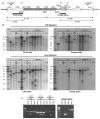Virus-free induction of pluripotency and subsequent excision of reprogramming factors
- PMID: 19252477
- PMCID: PMC2667910
- DOI: 10.1038/nature07864
Virus-free induction of pluripotency and subsequent excision of reprogramming factors
Abstract
Reprogramming of somatic cells to pluripotency, thereby creating induced pluripotent stem (iPS) cells, promises to transform regenerative medicine. Most instances of direct reprogramming have been achieved by forced expression of defined factors using multiple viral vectors. However, such iPS cells contain a large number of viral vector integrations, any one of which could cause unpredictable genetic dysfunction. Whereas c-Myc is dispensable for reprogramming, complete elimination of the other exogenous factors is also desired because ectopic expression of either Oct4 (also known as Pou5f1) or Klf4 can induce dysplasia. Two transient transfection-reprogramming methods have been published to address this issue. However, the efficiency of both approaches is extremely low, and neither has been applied successfully to human cells so far. Here we show that non-viral transfection of a single multiprotein expression vector, which comprises the coding sequences of c-Myc, Klf4, Oct4 and Sox2 linked with 2A peptides, can reprogram both mouse and human fibroblasts. Moreover, the transgene can be removed once reprogramming has been achieved. iPS cells produced with this non-viral vector show robust expression of pluripotency markers, indicating a reprogrammed state confirmed functionally by in vitro differentiation assays and formation of adult chimaeric mice. When the single-vector reprogramming system was combined with a piggyBac transposon, we succeeded in establishing reprogrammed human cell lines from embryonic fibroblasts with robust expression of pluripotency markers. This system minimizes genome modification in iPS cells and enables complete elimination of exogenous reprogramming factors, efficiently providing iPS cells that are applicable to regenerative medicine, drug screening and the establishment of disease models.
Figures



Comment in
-
Stem cells: Low-risk reprogramming.Nature. 2009 Apr 9;458(7239):715-6. doi: 10.1038/458715a. Nature. 2009. PMID: 19360075 No abstract available.
References
-
- Takahashi K, Yamanaka S. Induction of pluripotent stem cells from mouse embryonic and adult fibroblast cultures by defined factors. Cell. 2006;126:663–676. - PubMed
-
- Wernig M, et al. In vitro reprogramming of fibroblasts into a pluripotent ES-cell-like state. Nature. 2007;448:318–324. - PubMed
-
- Maherali N, et al. Directly reprogrammed fibroblasts show global epigenetic remodeling and widespread tissue contribution. Cell Stem Cell. 2007;1:55–70. - PubMed
-
- Takahashi K, et al. Induction of pluripotent stem cells from adult human fibroblasts by defined factors. Cell. 2007;131:861–872. - PubMed
-
- Yu J, et al. Induced pluripotent stem cell lines derived from human somatic cells. Science. 2007;318:1917–1920. - PubMed
Publication types
MeSH terms
Substances
Grants and funding
LinkOut - more resources
Full Text Sources
Other Literature Sources
Research Materials

